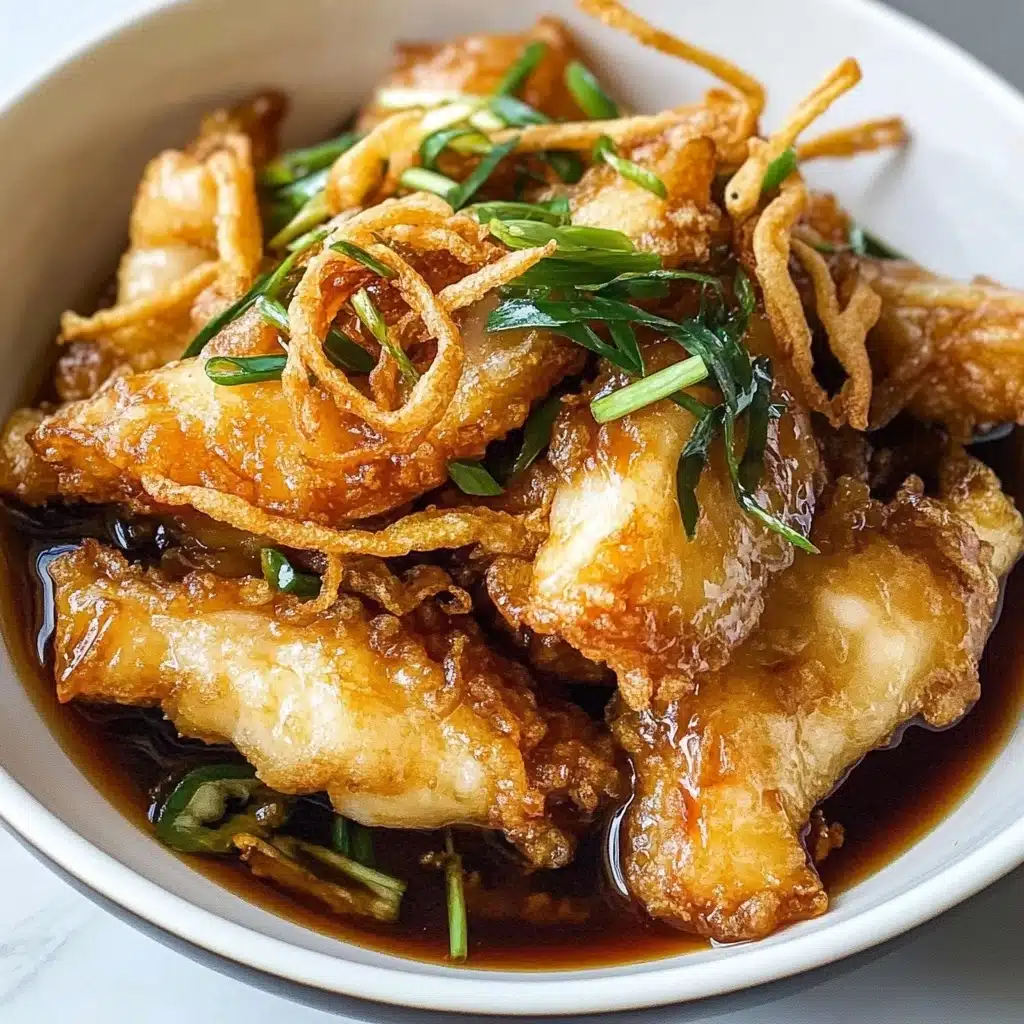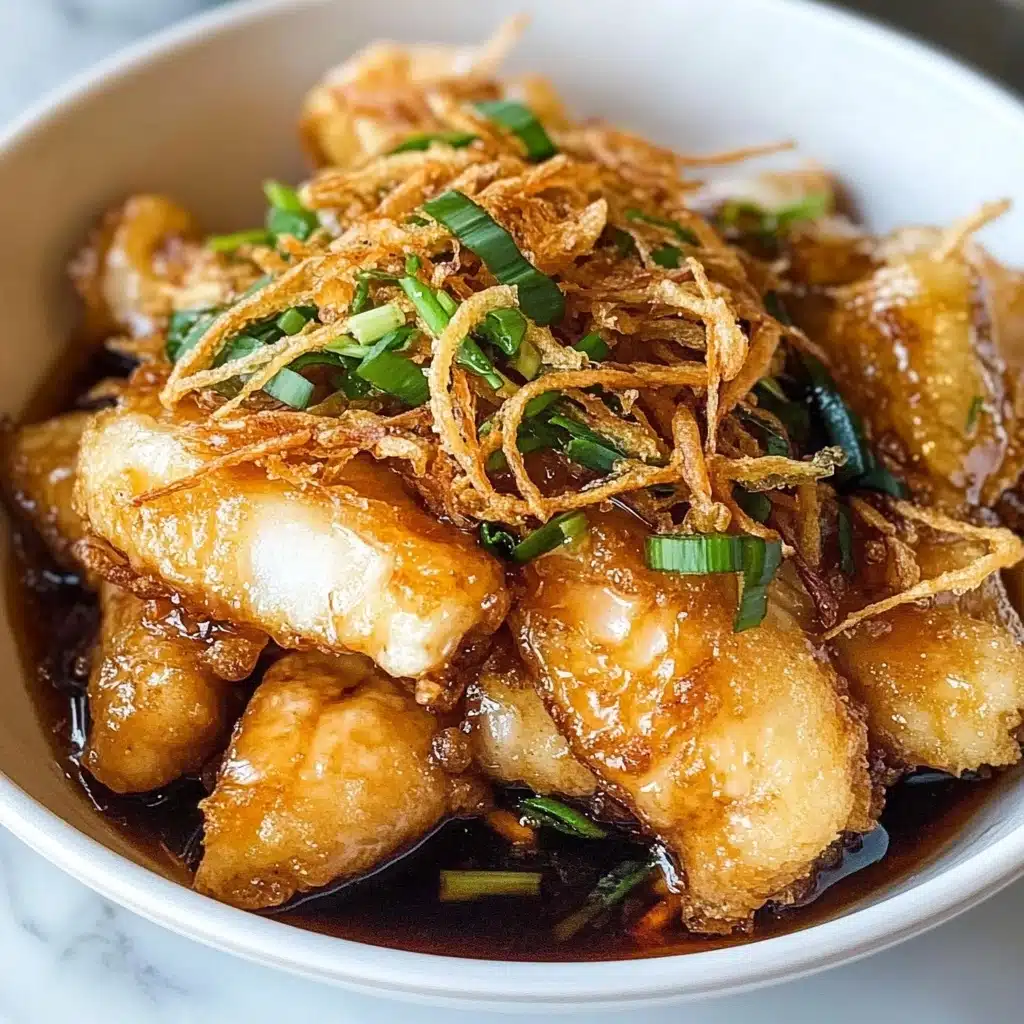This Ginger Soy Fish is one of those recipes that never fails to deliver restaurant-style flavor in less time than it takes to order takeout. Tender, flaky white fish is pan-seared to golden perfection and then cloaked in a luscious, aromatic ginger soy sauce that hits every savory note. It’s quick enough for a busy weeknight but special enough to wow guests—you’re going to fall in love with how easy and delicious it is!
Why You’ll Love This Recipe
- Effortlessly Elegant: Impressive presentation with minimal effort, thanks to the glistening ginger soy glaze and delicate fish fillets.
- Big Flavor, Short Time: The sauce bursts with umami and bright ginger notes—all ready in about 20 minutes from start to finish.
- Super Versatile: Works beautifully with any firm white fish, so you can use what’s fresh or already in your freezer.
- Healthy Comfort Food: Light, satisfying, and loaded with fresh, feel-good ingredients—perfect for when you’re craving both nourishment and flavor.
Ingredients You’ll Need
You’ll be amazed by how this Ginger Soy Fish comes together with just a handful of everyday pantry staples and a few fresh touches. Each ingredient plays a unique role, from the crispness of ginger to the savory depth of soy, so don’t skip a thing!
- Halibut fish fillet (or other white fish): Firm, mild, and perfect for soaking up all the delicious flavors; cod, pollock, snapper, or sole also work.
- Cornstarch: Lightly coats the fish, creating that irresistible golden crust and sealing in the juiciness.
- Fresh ginger: Sliced into thin strips, it infuses the oil and sauce with deep, aromatic zing.
- Cooking oil: Helps crisp up the fish without sticking—choose a neutral one like canola or sunflower.
- Chopped scallions: Adds a fresh, bright finish that complements the savory sauce.
- Soy sauce: The backbone of the sauce, bringing classic savory and umami richness.
- Water: Keeps the sauce glossy and light so it doesn’t overwhelm the fish.
- Sugar: Balances out the saltiness and boosts caramelization.
- Sesame oil: Adds toasty, nutty aroma that makes the whole dish pop.
- Ground white pepper: Gives gentle heat without overpowering the other flavors.
Variations
One of the joys of making Ginger Soy Fish is how endlessly adaptable it is. You can easily switch up the flavors to suit what you have in the kitchen, your dietary needs, or even just to add your own twist!
- Use Salmon or Trout: Swap the white fish for rich salmon or delicate trout for a heartier, omega-3-packed version.
- Make it Gluten-Free: Use tamari or a gluten-free soy sauce to keep every bite perfectly compliant (and just as tasty!).
- Add a Spice Kick: Toss in a little fresh red chili or a pinch of chili flakes to crank up the heat.
- Boost with Veggies: Layer sautéed bok choy, snap peas, or baby spinach alongside the fish for a complete meal.
- Try Black Pepper Sauce: Sub the white pepper for freshly ground black pepper and add a dash more sugar for extra depth and warmth.
How to Make Ginger Soy Fish
Step 1: Prep the Fish
Start by cutting your white fish fillet into thick, bite-sized pieces—about 2 inches wide is perfect. Pat them dry with a paper towel, then gently toss them in cornstarch, making sure each piece is well-coated. This helps create that gorgeously crisp, golden surface and keeps the fish perfectly moist while cooking.
Step 2: Slice the Ginger
Peel the ginger with the edge of a spoon or a peeler, then slice it into delicate, thin strips. These ginger matchsticks will infuse the oil with bold flavor and provide a lovely aromatic garnish at the end.
Step 3: Mix the Sauce
In a small bowl, whisk together soy sauce, water, sugar, sesame oil, and white pepper. Stir until the sugar dissolves completely. This simple sauce will soon become your new go-to for saucing up other proteins and veggies, too!
Step 4: Fry the Ginger
Heat your cooking oil in a non-stick skillet or well-seasoned wok over medium-high heat. Once hot, add those ginger strips and stir-fry until they’re fragrant and golden brown, about 1–2 minutes. Scoop the crispy ginger out and set it aside—you’ll use it as the finishing touch.
Step 5: Pan-Fry the Fish
Using that flavorful, ginger-infused oil, gently lay the fish pieces in a single layer in the skillet. Let them cook undisturbed for a minute or two, then carefully flip with a spatula, tongs, or a pair of chopsticks so both sides develop a beautiful golden-brown crust. Be gentle—these fillets are delicate and deserve a soft touch!
Step 6: Simmer in Sauce & Finish
Pour the sauce over the fish. When it starts to bubble, turn off the heat. The sauce will thicken slightly and coat each piece. Transfer the fish to a plate, then shower it with the crisped ginger and a generous scattering of chopped scallions. Serve your Ginger Soy Fish right away with hot steamed rice—or just dig in and savor every bite!
Pro Tips for Making Ginger Soy Fish
- Choose Firm White Fish: Halibut, cod, or snapper hold together nicely during pan-frying and soak up the sauce beautifully.
- Crisp Up the Ginger: Fry ginger strips until golden for maximum aroma—don’t rush this step, as the crispy ginger is a flavor bomb and the ultimate garnish!
- Coat Fish Evenly: Shake off excess cornstarch—too much can make the coating gummy instead of crisp.
- Gentle Flipping: Use chopsticks or a wide spatula to turn fish without breaking it, ensuring picture-perfect presentation every time.
How to Serve Ginger Soy Fish

Garnishes
For a vibrant, restaurant-worthy finish, generously top your Ginger Soy Fish with the crispy fried ginger strips you reserved earlier and a shower of fresh chopped scallions. If you’re feeling extra, a sprinkle of toasted sesame seeds or a few slivers of red chili can add both color and a hint of heat.
Side Dishes
The most classic companion for Ginger Soy Fish is fluffy steamed jasmine rice, which soaks up every drop of that glossy sauce. For a more complete table, add garlicky sautéed greens, a simple cucumber salad, or steamed bok choy tossed with a pinch of sesame oil.
Creative Ways to Present
Try serving your Ginger Soy Fish in shallow bowls with rice on the side for a modern bistro feel, or layer the fish over a bed of sautéed Asian greens for an elegant dinner party plate. For family-style meals, present the fish atop a platter with vivid garnishes center-stage—everyone will be reaching for seconds!
Make Ahead and Storage
Storing Leftovers
If you happen to have any Ginger Soy Fish left, store it in an airtight container in the refrigerator for up to two days. The flavors get even more intense overnight, and the fish stays moist when reheated gently.
Freezing
Freeze cooked Ginger Soy Fish portions in airtight containers for up to one month. Thaw overnight in the refrigerator for best texture; just keep in mind that fish is always at its prime right after cooking!
Reheating
For best results, gently reheat Ginger Soy Fish in a covered skillet over low heat, adding a splash of water to loosen the sauce. Avoid microwaving for too long, as it can make the fish rubbery—low and slow keeps it tender.
FAQs
-
Can I use frozen fish fillets for Ginger Soy Fish?
Absolutely! Just be sure to fully thaw the fish overnight in the refrigerator and pat it dry before coating with cornstarch. Removing excess moisture helps you get that lovely, crisp crust when frying.
-
What type of soy sauce should I use for Ginger Soy Fish?
Regular light soy sauce gives the best balance of saltiness and color, but you can use low-sodium for a lighter touch, or tamari for a gluten-free option. Avoid dark soy sauce, as it can overpower the delicate fish flavor and turn the sauce too sweet or heavy.
-
Is this recipe suitable for meal prep?
Ginger Soy Fish is at its peak when freshly cooked, but you can prep the sauce and ginger ahead of time. The fish can be coated just before frying for the best texture. Store leftovers for up to two days and reheat gently to keep the fish moist.
-
Can I make Ginger Soy Fish without cornstarch?
If you prefer to skip cornstarch, you can pan-fry the fish plain, though you won’t get quite the same golden crust. Alternatively, a light dusting of rice flour or potato starch will deliver a similar effect, keeping the fish tender and lightly crisp.
Final Thoughts
I hope you feel inspired to make Ginger Soy Fish part of your weeknight lineup—or your next special occasion! It’s a dish that truly tastes like something from your favorite Asian restaurant, but with all the cozy, home-cooked touches you crave. Grab your chopsticks (or a fork!) and dig in—you’re going to love every fragrant, flavorful bite.
Print
Ginger Soy Fish Recipe
- Prep Time: 10 minutes
- Cook Time: 10 minutes
- Total Time: 20 minutes
- Yield: 2 servings
- Category: Main Dish
- Method: Pan-Frying
- Cuisine: Asian
- Diet: Low Calorie
Description
This Ginger Soy Fish recipe is a delightful dish that combines the flavors of ginger and soy sauce to create a delicious and aromatic meal. Perfect for a quick and easy dinner, this recipe is sure to impress your family and friends.
Ingredients
Fish:
- 12 oz (350g) halibut fish fillet or other white fish
- 1 tablespoon cornstarch
Sauce:
- 2 tablespoons soy sauce
- 2 tablespoons water
- 1 tablespoon sugar
- 1 teaspoon sesame oil
- 3 dashes ground white pepper
Others:
- 2-inch (5cm) ginger, peeled, sliced, and cut into thin strips
- 2 tablespoons cooking oil
- 1 tablespoon chopped scallions
Instructions
- Cut the fish: Cut the fish into thick, bite-sized pieces. Coat with cornstarch and set aside.
- Prepare ginger: Slice ginger into thin strips.
- Make sauce: Mix soy sauce, water, sugar, sesame oil, and white pepper in a bowl.
- Cook ginger: Stir-fry ginger in heated oil until light brown, then set aside.
- Cook fish: Pan-fry fish in ginger-infused oil until golden brown.
- Add sauce: Pour sauce over fish, let it bubble, then remove from heat.
- Serve: Top with ginger strips and scallions. Serve with steamed rice.
Notes
- White fish includes halibut, pollock, cod, snapper, sole, or flounder.
- Use firm white fish for better cooking results.
Nutrition
- Serving Size: 1 serving
- Calories: 275 kcal
- Sugar: 4g
- Sodium: 820mg
- Fat: 13g
- Saturated Fat: 2g
- Unsaturated Fat: 9g
- Trans Fat: 0g
- Carbohydrates: 10g
- Fiber: 1g
- Protein: 27g
- Cholesterol: 55mg




Hi there i am kavin, its my first time to commenting anyplace, when i read this paragraph i thought i could also make comment due to this brilliant paragraph.